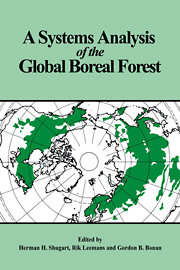Book contents
- Frontmatter
- Contents
- List of contributors
- 1 Introduction
- Part 1 Processes in boreal forests
- Introduction
- 2 Silvics of the circumpolar boreal forest tree species
- 3 The reproductive process in boreal forest trees
- 4 Soil temperature as an ecological factor in boreal forests
- 5 Fire as a controlling process in the North American boreal forest
- 6 The role of forest insects in structuring the boreal landscape
- Part 2 Patterns in space and time in boreal forests
- Part 3 Computer models for synthesis of pattern and process in the boreal forest
- References
- Index
2 - Silvics of the circumpolar boreal forest tree species
Published online by Cambridge University Press: 12 January 2010
- Frontmatter
- Contents
- List of contributors
- 1 Introduction
- Part 1 Processes in boreal forests
- Introduction
- 2 Silvics of the circumpolar boreal forest tree species
- 3 The reproductive process in boreal forest trees
- 4 Soil temperature as an ecological factor in boreal forests
- 5 Fire as a controlling process in the North American boreal forest
- 6 The role of forest insects in structuring the boreal landscape
- Part 2 Patterns in space and time in boreal forests
- Part 3 Computer models for synthesis of pattern and process in the boreal forest
- References
- Index
Summary
Introduction
The development of mechanistic approaches in the study of forest ecosystem dynamics over the past 16 years has increasingly drawn scientific attention to autecological characteristics of forest tree species. Model exercises have shown that emergent properties of forest ecosystems are predictable from interactions of species-specific life history attributes (e.g. Shugart 1984). This chapter presents silvical data for the dominant boreal tree species in the northern hemisphere to be used with ecosystem analysis and modeling studies of the circumpolar boreal forests. The selection of the species is based on distribution maps provided by Sokolov, Svyaseva & Kubly (1977) for the Eurasian species and by Fowells (1965) for the North American ones, as well as on boreal zone maps by Hämet-Ahti (1981). Fourteen tree species have been found to dominate the boreal zone in Fennoscandia and the USSR (Fig. 2.1); fifteen dominate North America. Section 2 of this chapter presents autecological reviews for the boreal tree species in Eurasia. Detailed reviews for the North American boreal tree species have been omitted since they are already available (e.g. Fowells 1965; Harlow, Harrar & White 1979) and because of publication limitations. However, North American boreal tree species have been included in Section 3 of this chapter, which provides species life-history data for parametrization of boreal forest simulation models. Data for silvics of the Eurasian boreal tree species have been extracted from both published and unpublished literature sources in six languages (Bulgarian, English, Finnish, German, Russian and Swedish) and have been collected according to the following scheme.
- Type
- Chapter
- Information
- A Systems Analysis of the Global Boreal Forest , pp. 13 - 84Publisher: Cambridge University PressPrint publication year: 1992
- 68
- Cited by



